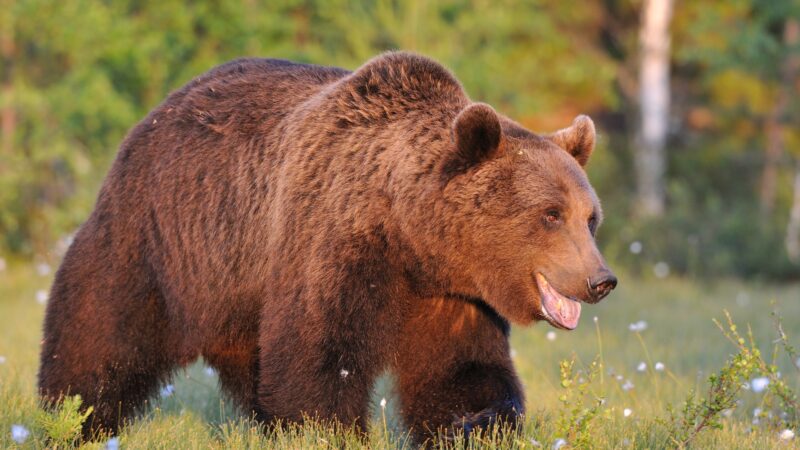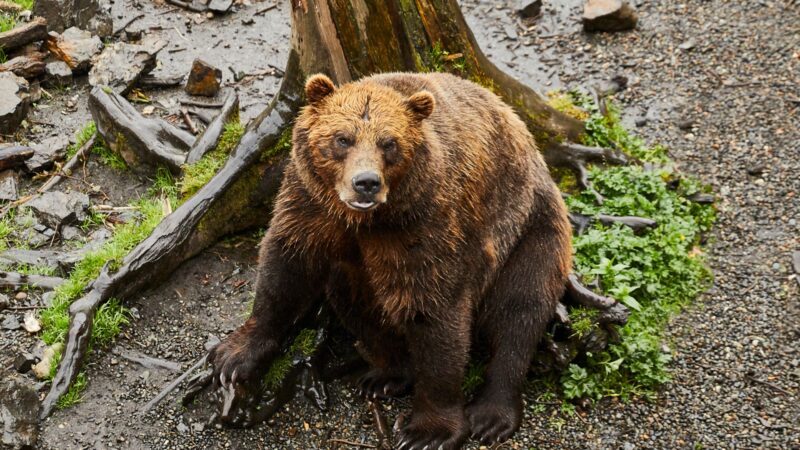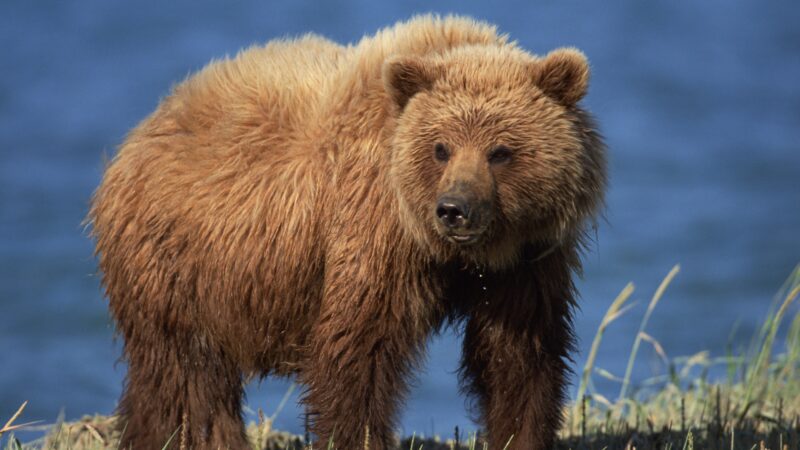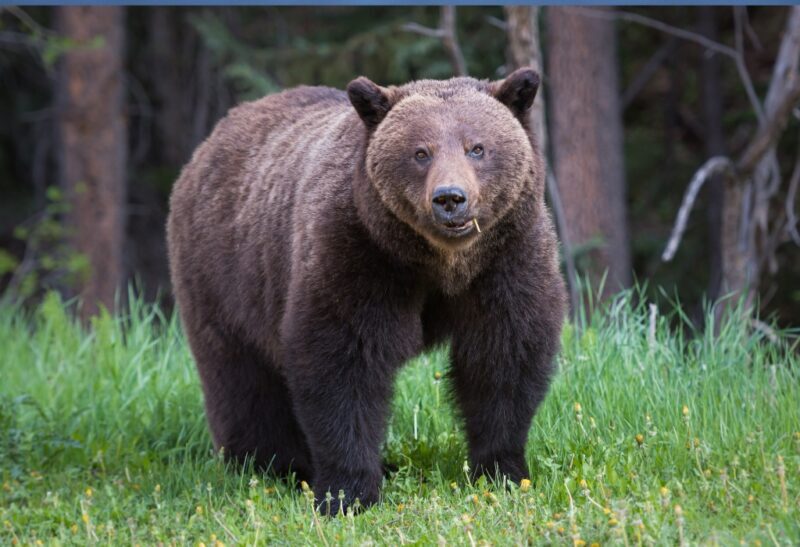Bears are dangerous wild animals that exhibit unpredictable behavior. Although human-bear interactions are uncommon, and attacks are even rarer, they can still resort to aggression when they feel threatened.
It’s important to distinguish the different types of bears to be prepared on the rare occasion that you encounter them.
Grizzly bears (Ursus arctos horribilis) and Kodiak bears (Ursus arctos middendorffi) are both subspecies of the brown bear (Ursus arctos). However, the difference lies in their geographic ranges—Brown bears live on the coast, Grizzlies are found inland, and Kodiaks inhabit Kodiak Island—which ultimately influences their size, color, and diet.
To know more about these bears, their physical attributes, habitats, geographical ranges, food preferences, distinctive characteristics, and other interesting information, simply read further this article!
Table of Contents
What US States Have Grizzly Bears?
There are only 5 US states that grizzly bears inhabit, and these are the following:
- Alaska – Population: 30,000
- Idaho – Population: 80 to 100
- Montana – Population: 1,800 to 2,000
- Washington – Population: Less than 20
- Wyoming – Population: Around 600
Are Brown Bears and Grizzlies the Same?
Brown bears and grizzlies are not the same. Although both have similar physical characteristics such as humped shoulders, concave facial profile, short and round ears, and long front claws, they are different in terms of geographical location and, consequently also differ in size, color, and diet.
Grizzly bears are subspecies of brown bears that live inland. Hence, they have no access to salmon and other marine-derived food resources. They have distinct light-colored hair tips, which gives them a “grizzly” appearance.
On the other hand, brown bears are located in coastal areas, are bigger in size, and darker in color, although they can range from cream to nearly black.
Brown Bears of North America
Grizzly Bears
They are named after their dense fur coats which tend to look frosted or “grizzly” in coloration. Grizzly bears are highly intelligent mammals with excellent memory.
Also, they have keen sense of smell believed to be better than hound dogs, and great, human-level hearing. They traveled to North America coming from Eurasia about 50,000 years ago before settling in various states 13,000 years ago.
- Scientific Name: Ursus arctos horribilis
- Appearance: Large and heavy-bodied bears with massive heads, rounded and inconspicuous ears, prominent noses, small eyes, humped shoulders, concave facial profiles, and short tails. Their coat consists of long guard hairs and dense underfur.
- Color: Medium to dark brown fur with a lighter shade on the back and head, as well as a light patch found on the back of their front legs. Their underfur can also be silver or golden in color.
- Lifespan: Up to 30 years (wild), up to 50 years (captivity)
- Habitat: High mountain forests, desert edges, meadows, ice fields, coastlines, tundra, mixed shrub fields, sidehill parks, and alpine meadows
- Height: 1 to 2.8 meters
- Weight: 80 to 600 kilograms
- Diet: Plant material such as sedges, grass, moss, roots, and bulbs as well as fruits, tubers, berries, nuts, and bulbs. They also feed on insects, and small mammals such as ground squirrels, mice, and fungi.
- Place Of Origin: Eurasia
- Characteristics: Can be active at any time of the day but is usually crepuscular. Migratory, territorial, and solitary but may occasionally forage for food with other individuals.
Kodiak Bears

Kodiak bears are considered a unique subspecies of the brown bear as they have been living in isolation from other bears for approximately 12,000 years. They are even larger bears than polar bears.
Just like grizzly and black bears, they can sleep for up to 8 months without drinking, eating, defecating, or urinating.
- Scientific Name: Ursus arctos middendorffi
- Appearance: Incredibly large bears with a slightly concave face, humped between the shoulders, short and rounded ears, and long, prominent claws
- Color: Pelage can be varying shades of brown and can even be brownish orange or blonde in coloration. Their fur looks shaggy in the early summer and sleek as the season ends. It’s at its thickest during the fall season, right before hibernation.
- Lifespan: Up to 30 years (wild), up to 40 years (captivity)
- Habitat: Dense forests, glaciated mountains, flat tundra, rolling hills, rocky snow-covered snakes, and hillside burrows.
- Height: 90 centimeters to 3 meters
- Weight: 181 to 365 kilograms
- Diet: Mostly forbes and berries, sedges, and salmon, but they consume almost any plant and animal matter they can forage. They are also known to feed on mountain goats, deer, and elk on occasion, as well as birds, rodents, marine mammals, and invertebrates.
- Place Of Origin: Kodiak Archipelago in Alaska
- Characteristics: Diurnal but tends to be nocturnal in the presence of humans, solitary except when forming mother-offspring groups and foraging, non-territorial, and non-migratory.
Other Brown Bears Found in North America
Stickeen Brown Bear

Also known as the Stikine brown bear, this subspecies of brown bear is named after its geographical range, which is from the Stikine River to the Skeena River. It used to be considered a variant of the grizzly bear but is now recognized as a subspecies of the brown bear.
- Scientific Name: Ursus arctos stikeenensis
- Appearance: A large bear with long guard hairs from its humped shoulders down to its back, a slightly concave facial profile, and long front claws
- Color: Generally dark brown pelage but can range from blonde to black. They have a grizzled appearance since their guard hairs are tipped with a light color.
- Lifespan: 20 to 30 years (wild)
- Habitat: Lake basins, river valleys, and forests found in remote mountainous areas
- Height: 2.4 to 3 meters
- Weight: 95 to 390 kilograms
- Diet: Plant material such as sedges, roots, grasses, seeds, tubers, and berries. They also consume small mammals, salmon, carrion, and the newborn of caribou and moose.
- Place Of Origin: Northwestern Canada
- Characteristics: Not much is known about the Stickeen bear but it can be assumed that they are crepuscular, generally solitary except when forming family groups and foraging for food, migratory, and territorial.
Dall Brown Bear

Named after their geographical range in Dall Island, located near continental ice sheets above sea level, making it home for the bears, Dall brown bears are either recognized as its distinct subspecies or merely a coastal variation of Alaska’s various brown bear subspecies.
- Scientific Name: Ursus arctos dalli
- Appearance: Large-sized bear with distinctive humped shoulders, slightly dished facial profile and noticeably long front claws.
- Color: Commonly dark brown but can range from blonde to black. It has a grizzled appearance due to the light-colored tips of its guard hairs that trail over its shoulders down to its back.
- Lifespan: 20 to 30 years (wild)
- Habitat: Coastal zones and inland forests
- Height: 2.4 to 3 meters
- Weight: 95 to 390 kilograms
- Diet: Common food items are grasses, berries, sedges, roots, salmon, ground squirrels, cow parsnip, and carrion.
- Place Of Origin: Dall Island, Alaska
- Characteristics: Not much is known about the Sitka brown bear, but it can be assumed that they are crepuscular, generally solitary except when forming family groups and foraging for food, migratory, and territorial.
Sitka Brown Bear

This brown bear subspecies has a unique genetic structure because not only is it related to brown bears, but Sitka brown bears are also of polar bear ancestry.
According to DNA researchers, the likely explanation of such hybridization is that male Sitka brown bears may have wandered onto the islands of Alaska and gradually altered the population of polar bears into brown bears.
- Scientific Name: Ursus arctos sitkensis
- Appearance: Massively-sized bear with a slightly concave facial profile, humped back, and long front claws.
- Color: Generally a chocolate brown color but can also be blonde to black with light-colored tips
- Lifespan: 20 to 30 years (wild)
- Habitat: Coastal zones and inland forests, preferably with an abundance of western hemlock and Sitka spruce trees
- Height: 2.4 to 3 meters
- Weight: 95 to 390 kilograms
- Diet: Grasses, bulbs, berries (such as blueberries and salmonberries), mushrooms, and other plant material. They also eat squirrels, mice, voles, and salmon.
- Place Of Origin: Islands of Admiralty, Baranof, and Chichagof in Alaska
- Characteristics: Not much is known about the Sitka brown bear, but it can be assumed that they are crepuscular, generally solitary except when forming family groups and foraging for food, migratory, and territorial.
Alaska Peninsula Brown Bear

Also called the peninsular grizzly, these bears refer to either grizzly bears or kodiak bears that inhabit the coastal areas of Southern Alaska. It was considered the same species as brown bears from 1975 onwards—before this, they were thought to be different from inland grizzly bears due to color and size differences.
- Scientific Name: Ursus arctos horribilis or Ursus arctos middendorffi
- Appearance: Among the largest brown bears in the world, they are massively sized with pronounced humped shoulders.
- Color: Typically brown in coloration with white-tipped guard hairs, but they can also vary from blonde to nearly black.
- Lifespan: 20 to 30 years (wild)
- Habitat: Areas preferably near connecting rivers and large lakes where there is an abundance of salmon
- Height: 2.4 to 3 meters
- Weight: 360 to 771 kilograms
- Diet: Salmon (sockeye and chum), tidal vegetation, plant material (sedges, grasses, roots, seeds, tubers, berries), small mammals, and carrion.
- Place Of Origin: Alaska Peninsula
- Characteristics: Can be active at any time of the day but is usually crepuscular. Migratory, territorial, and solitary but may occasionally forage for food with other individuals.
Frequently Asked Questions
How Fast Can a Kodiak Bear Run?
A Kodiak bear can run as fast as 25 to 35 miles per hour.
What’s the Most Aggressive Bear?
Polar bears are considered the most aggressive bears since they have no fear of humans and can resort to aggression relatively quickly. This is because global warming is continuously melting polar ice caps, prompting the bears to find colder waters or swim to the shore, which increases the possibility of human-bear interactions.
Why Are There No Brown Bears in California?
Bears in California have been extirpated from the state, with the last grizzly bear killed in 1924. Historically, their range included California, but due to hunting, brown bear populations swiftly declined.
List of Sources
Polar Bears. Exploratorium.
Dickie, Gloria. (2018). As Polar Bear Attacks Increase in Warming Arctic, a Search for Solutions. Yale School of the Environment.
Ballenger, L. (2002). Ursus arctos. Animal Diversity Web.
Brown Bear (Ursus arctos). State of Alaska · Department of Fish and Game.
